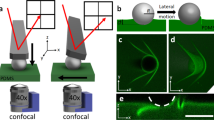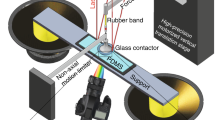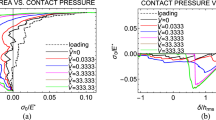Abstract
Interfacial adhesion and friction are important factors in determining the performance and reliability of microelectro- mechanical systems. We demonstrate that the adhesion of micromachined surfaces is in a regime not considered by standard rough surface adhesion models. At small roughness values, our experiments and models show unambiguously that the adhesion is mainly due to van der Waals dispersion forces acting across extensive non-contacting areas and that it is related to 1/Dave2, where Dave is the average surface separation. These contributions must be considered because of the close proximity of the surfaces, which is a result of the planar deposition technology. At large roughness values, van der Waals forces at contacting asperities become the dominating contributor to the adhesion. In this regime our model calculations converge with standard models in which the real contact area determines the adhesion. We further suggest that topographic correlations between the upper and lower surfaces must be considered to understand adhesion completely.
This is a preview of subscription content, access via your institution
Access options
Subscribe to this journal
Receive 12 print issues and online access
$259.00 per year
only $21.58 per issue
Buy this article
- Purchase on Springer Link
- Instant access to full article PDF
Prices may be subject to local taxes which are calculated during checkout






Similar content being viewed by others
References
Van Kessel, P. F., Hornbeck, L. J., Meier, R. E. & Douglass, M. R. MEMS-based projection display. Proc. IEEE 86, 1687–1704 (1998).
Chau, K. H. L. & Sulouff, R. E. Technology for the high-volume manufacturing of integrated surface-micromachined accelerometer products. Microelectr. J. 29, 579–586 (1998).
Yao, J. J. RF MEMS from a device perspective. J. Micromech. Microeng. 10, R9–R38 (2000).
Eldada, L. Advances in telecom and datacom optical components. Opt. Eng. 40, 1165–1178 (2001).
Maboudian, R. & Howe, R. T. Critical review: adhesion in surface micromechanical structures. J. Vac. Sci. Technol. B 15, 1–20 (1997).
Maboudian, R. & Carraro, C. Surface chemistry and tribology of MEMS. Annu. Rev. Phys. Chem. 55, 35–54 (2004).
Srinivasan, U., Houston, M. R., Howe, R. T. & Maboudian, R. Alkyltrichlorosilane-based self-assembled monolayer films for stiction reduction in silicon micromachines. J. Microelectromech. Syst. 7, 252–260 (1998).
Kim, B. H., Chung, T. D., Oh, C. H. & Chun, K. A new organic modifier for anti-stiction. J. Microelectromech. Syst. 10, 33–40 (2001).
Ashurst, W. R. et al. Alkene based monolayer films as anti-stiction coatings for polysilicon MEMS. Sensors Actuat. A 91, 239–248 (2001).
London, F. The general theory of molecular forces. Trans. Faraday Soc. 33, 8–26 (1937).
Israelachvili, J. & Tabor, D. The measurement of van der Waals dispersion forces in the range 1.5 to 130 nm. Proc. R. Soc. Lond. A 331, 19–38 (1972).
Tabor, D. & Winterton, R. H. S. The direct measurement of normal and retarded van der Waals forces. Proc. R. Soc. Lond. A 312, 435–450 (1969).
Casimir, H. B. G. & Polder, D. The influence of retardation on the London – van der Waals forces. Phys. Rev. 73, 360–372 (1948).
Serry, F. M., Walliser, D. & Maclay, G. J. The role of the Casimir effect in the static deflection and stiction of membrane strips in microelectromechanical systems (MEMS). J. Appl. Phys. 84, 2501–2506 (1997).
Anandarajah, A. & Chen, J. Single correction function for computing retarded van der Waals attraction. J. Colloid Interface Sci. 176, 293–300 (1995).
Fuller, K. N. G. & Tabor, D. The effect of surface roughness on the adhesion of elastic solids. Proc. R. Soc. Lond. A 345, 327–342 (1975).
Maugis, D. On the contact and adhesion of rough surfaces. J. Adhes. Sci. Technol. 10, 161–175 (1996).
Buks, E. & Roukes, M. L. Stiction, adhesion energy, and the Casimir effect in micromechanical systems. Phys. Rev. B 63, 033402 (2001).
Houston, M. R., Howe, R. T. & Maboudian, R. Effect of hydrogen termination on the work of adhesion between rough polycrystalline silicon surfaces. J. Appl. Phys. 81, 3474–3483 (1997).
Komvopoulos, K. & Yan, W. A fractal analysis of stiction in microelectromechanical systems. J. Tribol. 119, 391–400 (1997).
De Boer, M. P. & Michalske, T. A. Accurate method for determining adhesion of cantilever beams. J. Appl. Phys. 86, 817–827 (1999).
Rogers, J. W., Mackin, T. J. & Phinney, L. M. A thermomechanical model for adhesion reduction of MEMS cantilevers. J. Microelectromech. Syst. 11, 512–520 (2002).
Jones, E. E., Begley, M. R. & Murphy, K. D. Adhesion of micro-cantilevers subjected to mechanical point loading: modeling and experiments. J. Mech. Phys. Solids 51, 1601–1622 (2003).
Sniegowski, J. J. & de Boer, M. P. IC-compatible polysilicon surface micromachining. Annu. Rev. Mater. Sci. 30, 299–333 (2000).
Sze, S. M. (ed.) VLSI Technology (McGraw-Hill, New York, 1983).
Knapp, J. A. & de Boer, M. P. Mechanics of microcantilever beams subject to combined electrostatic and adhesive forces. J. Microelectromech. Syst. 11, 754–764 (2002).
De Boer, M. P., Knapp, J. A., Michalske, T. A., Srinivasan, U. & Maboudian, R. Adhesion hysteresis of silane coated microcantilevers. Acta Mater. 48, 4531–4541 (2000).
Xiao, X. & Linmao, Q. Investigation of humidity-dependent capillary force. Langmuir 16, 8153–8158 (2000).
He, M. et al. Critical phenomenon of water bridges in nanoasperity contacts. J. Chem. Phys. 114, 1355–1360 (2001).
De Boer, M. P., Clews, P. J., Smith, B. K. & Michalske, T. A. Adhesion of polysilicon microbeams in controlled humidity ambients. Mater. Res. Soc. Symp. Proc. 518, 131–136 (1998).
Hertz, H. The contact of elastic solids. J. Reine Angew. Math. 92, 156–171 (1881).
Israelachvili, J. Intermolecular and Surface Forces (Academic, New York, 1992).
Brzoska, J. B., Ben Azouz, I. & Rondelez, F. Silanization of solid substrates: a step toward reproducibility. Langmuir 10, 4367–4373 (1994).
Johnson, K. L., Kendall, K. & Roberts, A. D. Surface energy and the contact of elastic solids. Proc. R. Soc. Lond. A 324, 301–313 (1971).
Perutz, S., Wang, J., Kramer, E. J. & Ober, C. K. Synthesis and surface energy measurement of semi-fluorinated, low-energy surfaces. Macromolecules 31, 4272–4276 (1998).
Jensen, B. D., de Boer, M. P., Masters, N. D., Bitsie, F. & LaVan, D. A. Interferometry of actuated microcantilevers to determine material properties and test structure nonidealities in MEMS. J. Microelectromech. Syst. 10, 336–346 (2001).
Acknowledgements
Sandia is a multiprogram laboratory operated by Sandia Corporation, a Lockheed Martin Company, for the US Department of Energy’s National Nuclear Security Administration under contract DE AC04-94AL85000. The authors would like to thank A. Corwin for help in collecting experimental data and B. McKenzie for the SEM images.
Author information
Authors and Affiliations
Corresponding author
Ethics declarations
Competing interests
The authors declare no competing financial interests.
Rights and permissions
About this article
Cite this article
DelRio, F., de Boer, M., Knapp, J. et al. The role of van der Waals forces in adhesion of micromachined surfaces. Nature Mater 4, 629–634 (2005). https://doi.org/10.1038/nmat1431
Received:
Accepted:
Published:
Issue Date:
DOI: https://doi.org/10.1038/nmat1431
This article is cited by
-
On the Van der Waals model on granular matters with truncated M-fractional derivative
Optical and Quantum Electronics (2024)
-
Precipitates Generation Mechanism and Surface Quality Improvement for Aluminum Alloy 6061 in Diamond Cutting
Journal of Wuhan University of Technology-Mater. Sci. Ed. (2024)
-
Sub-10 fJ/bit radiation-hard nanoelectromechanical non-volatile memory
Nature Communications (2023)
-
Wafer-scale alignment and integration of micro-light-emitting diodes using engineered van der Waals forces
Nature Electronics (2023)
-
Exploring the dynamics of viscoelastic adhesion in rough line contacts
Scientific Reports (2023)



